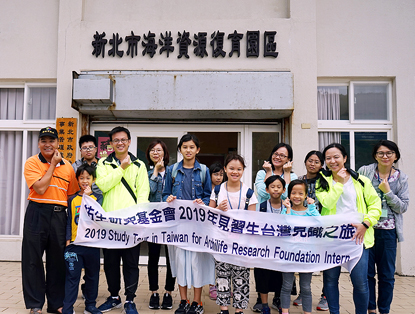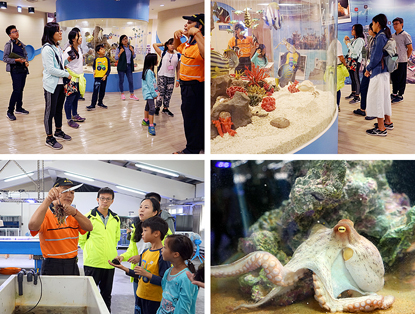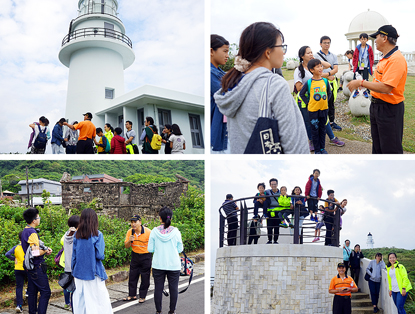Sketch of Archilife Study Tour, October 2019
|
2019年10月份見識之旅縮影  10月份見識之旅活動,於2019年10月19日由呂明澐小姐帶領10位祐生見習生及其家長們,進行東北角海洋生態暨古樸漁村漫遊之旅。出發當日天氣陰雨,然見習生們及其家長仍準時集合並出發。活動開始之初,領隊呂明澐小姐提醒本次活動注意事項及觀察重點,先行建立見習生的背景知識。 10月份見識之旅活動,於2019年10月19日由呂明澐小姐帶領10位祐生見習生及其家長們,進行東北角海洋生態暨古樸漁村漫遊之旅。出發當日天氣陰雨,然見習生們及其家長仍準時集合並出發。活動開始之初,領隊呂明澐小姐提醒本次活動注意事項及觀察重點,先行建立見習生的背景知識。For the study tour of October 19, 2019, Ms. Lu Ming-yun led 10 ARF interns and their parents to the northeast coast to learn about marine ecology and rustic fishing village. It was rainy on the day of the tour, and the interns and their parents were on time for the departure. At the start of the day's activities, team leader Ms. Lu Ming-yun reminded everyone about things to note and what to observe, and gave the interns some background knowledge.  本次以東北角為參訪主軸,由當地福連里里長吳文益先生擔任導覽老師。行程一開始,至新北市海洋資源復育園區參訪,里長講述過去卯澳灣一帶九孔養殖業的榮景,然因長年近親繁殖造成品種抵抗力弱,加上一些貪圖方便的業者低成本引進中國九孔苗,不料卻帶有疫病,導致當時九孔幾乎全軍覆沒,產業一片慘澹。緊接著,觀看新北市海洋資源影片,該片介紹卯澳灣周邊環境資源,並提及貢寮地區九孔養殖業的興衰及近期復育成果。隨後里長以卯澳灣空拍圖解說卯澳優越的地理位置及多樣的海洋環境,為加深學童與海洋的情感連結,當地小學將課程與在地產業及環境結合發展海洋教育,除了課堂上學習九孔養殖知識外,亦有潛水和海中泳技訓練,畢業生須泳渡卯澳灣,並潛水放流九孔苗,最後潛至海底領取自己的畢業證書。隨即前往培育室導覽,里長解說內部海濱生物特徵習性,鼓勵見習生以手觸摸體驗,透過親身感受認識海洋生物,進而培養海洋保育觀念。 本次以東北角為參訪主軸,由當地福連里里長吳文益先生擔任導覽老師。行程一開始,至新北市海洋資源復育園區參訪,里長講述過去卯澳灣一帶九孔養殖業的榮景,然因長年近親繁殖造成品種抵抗力弱,加上一些貪圖方便的業者低成本引進中國九孔苗,不料卻帶有疫病,導致當時九孔幾乎全軍覆沒,產業一片慘澹。緊接著,觀看新北市海洋資源影片,該片介紹卯澳灣周邊環境資源,並提及貢寮地區九孔養殖業的興衰及近期復育成果。隨後里長以卯澳灣空拍圖解說卯澳優越的地理位置及多樣的海洋環境,為加深學童與海洋的情感連結,當地小學將課程與在地產業及環境結合發展海洋教育,除了課堂上學習九孔養殖知識外,亦有潛水和海中泳技訓練,畢業生須泳渡卯澳灣,並潛水放流九孔苗,最後潛至海底領取自己的畢業證書。隨即前往培育室導覽,里長解說內部海濱生物特徵習性,鼓勵見習生以手觸摸體驗,透過親身感受認識海洋生物,進而培養海洋保育觀念。Centering on the northeast coast, the study tour was guided by Mr. Wu Wen-yih, chief of the local Fulian village. The tour began with a visit to New Taipei City Maritime Resources Recovery Park. Mr. Wu said there used to be a booming industry for the farming of the variously colored abalone in Maoao Bay. However, due to weakened immunity from prolonged inbreeding and the import of low-cost Chinese small abalone which were later found to carry diseases, the industry was almost entirely destroyed. Everyone watched a video introducing the environmental resources around Maoao Bay, the rise and fall of the small abalone farming industry in the Gongliao area and updates on small abalone restoration. Using aerial photos of Maoao Bay, Mr. Wu explained Maoao Bay's superior geographical position and diverse marine environment. To deepen the emotional connection between children and the ocean, marine education engaging the local industries and environment is integrated into the local elementary school curriculum. Besides learning about small abalone farming, diving and ocean swimming, students can only graduate after having swum across the Maoao Bay, released small abalone seeds underwater and dived to the ocean bed to retrieve their graduation certificate. During the tour of the nursery, Mr. Wu explained the internal characteristics of marine organisms and encouraged the interns to get to know these organisms by touching them, thus cultivating their concept of marine conservation.  中午飯後,眾人沿著步道前往三貂角燈塔,行至頂端,里長指出眼前海岸線蜿蜒處即卯澳灣,說明「卯」字由來有三,其一是從高處俯瞰海灣形似「卯」字,其二為漁村居民每日卯時清晨出海做事,其三即早期該處漁獲豐碩,漁民收入豐厚,而有台語賺大錢「卯死矣」的說法。接著參訪百年石頭厝建築,昔日北部濱海公路尚未開通,居民大多就地取材,以海岸的砂岩、礁石為建材,採用砌石、疊石工法建造,可從石砌的形式與精緻度看出屋主的經濟程度,其中石頭厝牆面砌法分為平形砌、人字砌及亂石砌,平形砌要另請師傅將石頭打磨平整,耗時耗工,多為有錢人家的住宅。活動過程中,里長以幽默風趣的口吻解說並熱情接待,與見習生互動良好。至此,本日活動已近尾聲,大家一起合照留念後搭車返程,並期待於下次見識之旅再相見。 中午飯後,眾人沿著步道前往三貂角燈塔,行至頂端,里長指出眼前海岸線蜿蜒處即卯澳灣,說明「卯」字由來有三,其一是從高處俯瞰海灣形似「卯」字,其二為漁村居民每日卯時清晨出海做事,其三即早期該處漁獲豐碩,漁民收入豐厚,而有台語賺大錢「卯死矣」的說法。接著參訪百年石頭厝建築,昔日北部濱海公路尚未開通,居民大多就地取材,以海岸的砂岩、礁石為建材,採用砌石、疊石工法建造,可從石砌的形式與精緻度看出屋主的經濟程度,其中石頭厝牆面砌法分為平形砌、人字砌及亂石砌,平形砌要另請師傅將石頭打磨平整,耗時耗工,多為有錢人家的住宅。活動過程中,里長以幽默風趣的口吻解說並熱情接待,與見習生互動良好。至此,本日活動已近尾聲,大家一起合照留念後搭車返程,並期待於下次見識之旅再相見。After lunch, everyone took the footpath to Sandiao Cape Lighthouse. At the top of the lighthouse, Mr. Wu pointed out Maoao Bay along the winding coastal line and said there are three probable reasons for the name of the bay. Firstly, the bay looks like the Chinese character for "mao" from a bird's eye perspective. Secondly, the character "mao" which means five to seven o'clock in the morning refers to the time the village fishermen go out to sea. Thirdly, the name implies "making big bucks" in Taiwanese as fishermen earned a lot of money from the bounteous ocean catch in the early days. In the next part of the itinerary, everyone visited ancient stone houses. In the past, before the northern coastal road was open, residents mostly used locally found materials, such as coastal sandstone and reef, to build houses by laying or stacking these materials. A house owner's economic status can be seen from the method and refinement of the stone-laying. The walls of the stone houses may be laid using the horizontal angle method, 45-degree-angle method and random laying method. To adopt the horizontal angle method, builders must polish and straighten the stones, making it highly labor-intensive and time-consuming, and is usually adopted by the wealthy. During the entire tour, Mr. Wu was humorous and friendly, and interacted well with the interns. At this point, the day's itinerary came to an end. Everyone took a group photo before heading back and looked forward to the next study tour. |

